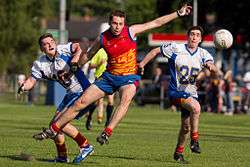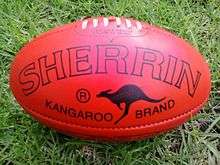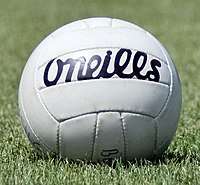Comparison of Gaelic football and Australian rules football
The comparison between Australian rules football and Gaelic football is the subject of controversy among historians. The question of whether the two codes of football, from Australia and Ireland respectively, have shared origins arises due to similar styles of play in both games.

Both Irish and Irish Australian historians, including Patrick O'Farrell, Marcus De Búrca, Chris McConville, B. W. O'Dwyer and Richard Davis, have supported the theory that the two games have some common origins. Other Australian historians, including Geoffrey Blainey, Leonie Sandercock and Ian Turner, have rejected any such connection,[1] emphasising instead the influence of rugby football and other games emanating from English public schools. Some sources also suggest that the Australian Aboriginal game of Marn Grook was an influence on Australian rules football.
In 1967, following approaches from Australian rules authorities, there was a series of games between an Irish representative team and an Australian team, under various sets of hybrid, compromise rules. In 1984, the first official representative matches of International rules football were played, and the Ireland international rules football team now plays the Australian team annually each October. Since the 1980s, some Gaelic players, such as Jim Stynes and Tadhg Kennelly, have been recruited by the professional Australian Football League (AFL) clubs and have had lengthy careers with them.
Aside from game-play, a social difference between the codes is that Gaelic football is strictly amateur, whereas Australian football offers professional (Australian Football League), (AFL Women’s) and semi-professional (VFL, SANFL, WAFL, etc.) levels of competition, providing a strong financial lure for Irish players to switch to Australian football.
Origins
Gaelic football
The earliest record of a recognised precursor to the modern game date from a match in County Meath in 1670, in which catching and kicking the ball was permitted.[2] The earliest recorded inter-county match in Ireland was one between Louth and Meath, at Slane, in 1712, about which the poet James Dall McCuairt wrote a poem of 88 verses beginning "Ba haigeanta".
Gaelic football was codified by the Gaelic Athletic Association (GAA) in 1887. GAA founder and Irish nationalist Michael Cusack wanted the rules of Gaelic football to differ from rugby union, which was making headway in Ireland at the time.
Australian rules football
Australian rules football was codified in 1859 by members of the Melbourne Football Club. The first rules were devised by the Australian-born Tom Wills, who was educated at Rugby School; Englishmen William Hammersley and J. B. Thompson, fellow students at Cambridge's Trinity College; and Irish Australian Thomas H. Smith, who played rugby football at Dublin University. Their knowledge of English public school football games, and the conditions and terrain of Melbourne's parklands, influenced the first rules of Australian football. It has been suggested that Wills was influenced by an Australian Aboriginal game, Marn Grook, as Wills grew up in an area where the game was played by local tribes.[3] Historians such as Geoffrey Blainey have argued that the origins of Australian rules football lie purely with rugby and other English public school games.
Gaelic football in Australia
In 1843, Irish immigrants in South Australia celebrated St Patrick's day by playing a game of caid in Thebarton.[4]
Some historians have argued that Gaelic football influenced Australian football. For example, Patrick O'Farrell has pointed out that the Irish sport of hurling, which has similar rules to Gaelic football, was played in Australia as early as the 1840s, and may also have been an influence on the Australian game.[5] B. W. O'Dwyer points out that Australian football has always been differentiated from rugby football by having no limitation on ball or player movement (in the absence of an offside rule), the need to bounce the ball (or toe-kick it, known as a solo in Gaelic football) while running, punching the ball (hand-passing) rather than throwing it, and other traditions. As O'Dwyer says:[6]
These are all elements of Irish football. There were several variations of Irish football in existence, normally without the benefit of rulebooks, but the central tradition in Ireland was in the direction of the relatively new game [i.e. rugby] … adapted and shaped within the perimeters of the ancient Irish game of hurling… [These rules] later became embedded in Gaelic football. Their presence in Victorian football may be accounted for in terms of a formative influence being exerted by men familiar with and no doubt playing the Irish game. It is not that they were introduced into the game from that motive [i.e. emulating Irish games]; it was rather a case of particular needs being met…
O'Dwyer's argument relies heavily on the presence of Irish immigrants on the Victorian goldfields during the Victorian gold rushes of the 1850s, and a comparison of the two modern games. There is no archival evidence to prove a direct influence of caid on Australian football.
Australian rules football in Ireland
Another theory suggests that influences may have originated from the opposite direction: Archbishop Thomas Croke, one of the founders of the GAA, was the Bishop of Auckland and lived in New Zealand between 1870 and 1875. As a result of the New Zealand gold rushes of the 1860s, there were many Australian-born settlers in New Zealand, and Victorian rules was popular there at the time. Croke therefore had an opportunity to witness the Australian game being played. Such claims are regarded by some historians as purely circumstantial evidence for a relationship between the two codes, and any resemblances are the result of something akin to parallel or convergent evolution. Geoffrey Blainey wrote:[7]
If an historian of football wishes to press the argument that one code must have copied the other, then this conclusion would be difficult to escape: the style of play which Gaelic and Australian football share today was visible in Australia long before it was visible in Ireland. By that line of reasoning Gaelic football must have been the imitator. The present evidence, however, suggests that Gaelic football made its own way … which happened to be—in the style rather than the formalities of play—in the Australian direction.
Table of comparison
This list is incomplete
| Rule or Term | Australian Football | Gaelic football | |
|---|---|---|---|
| Length of Game | 4 quarters (4 x 20 minutes) (total 80 minutes) | 2 halves (2 x 35 minutes) (total 70 minutes) | |
| Start of Game | Bounce and ruck contest (one player from each side only) | Ball up and contest (between four midfielders) | |
| Equipment | |||
| Ball shape | oval (prolate spheroid) | spherical | |
| Ball size | 720-735mm circumference, 545-555mm from end to end | 686mm-737mm in circumference | |
| Ball weight | 400–450 grams | 370–425 grams | |
| Uniform (jumper) | no or long sleeves | short or long sleeve | |
| Field | |||
| Shape | oval | rectangle | |
| Length | 135–185m | 130–145m | |
| Width | 110–155m | 80–90m | |
| Goal width | 6.4 m | 6.5 m | |
| Goal height | Unlimited | 2.5 m | |
| Point target | two 6.4 m wide zones of unlimited height either side of the goal | any height above the goal | |
| Advancing the ball | |||
| Methods of disposal | kick, handball (fist) | kick, handpass (open hand tap or fist) | |
| Maximum running distance allowed | Must bounce ball every 15 metres | Must bounce or solo (kick to self) every 4 steps (can't bounce twice consecutively) | |
| Ball goes out of bounds | throw-in; if out on full or ruled deliberate, free kick to opposite team | free kick to opposite team | |
| Contesting Possession | |||
| Tackling | full body tackling allowed above knees, below shoulders. free kick to tackler if player in possession does not dispose if ruled to have had prior opportunity. ball- up if ruled not to have had prior opportunity | wrestling or slapping the ball from the player in possession only | |
| Bumping (hip or shoulder charging) | any player within 5 metres of player in possession | player in possession only | |
| Catching the ball | free kick (mark) is paid if ball travels 15 metres or more if off a kick, play on if off a handpass or ball is touched by hand from a kick irrespective of distance | free kick (mark) is paid if ball caught from a kick-out on or past the 45m line. Otherwise play on.[8] | |
| Picking up ball | no restrictions | foot only (no restrictions in women's game) | |
| Scoring | |||
| Goal | 6 points | 6 points if scored through 2.5M goal | |
| Over | N/A | 3 points when kicked over the goal and between the two main goal posts | |
| Point | 1 point (behind) | 1 point | |
| Score goals by | foot or shin only | foot or shin if ball is being carried, any part if ball is loose or from a pass | |
| Score points by | any part of body (rushed) | any part of body (usually foot) | |
| Goalkeeper | No | Yes | |
Field


Both codes use grassed fields of similar length, however Australian Football fields are oval shaped, slightly longer and wider, usually cricket fields.
Another key difference is the score posts. Australian rules consists of four posts without a crossbar or net, whereas Gaelic football consists of two posts with crossbar and net.
The Gaelic football pitch is rectangular, stretching 130–145 metres long and 80–90 metres wide. There are H-shaped goalposts at each end with a net on the bottom section. Lines are marked at distances of 13 m, 20 m and 45 m from each end-line.
An Australian Football playing field, is oval shaped, and may be 135–185 m long and 110–155 m wide. It has a centre circle, centre square to control player positioning at start of play, and superficial markings including the 50-metre lines and goal squares.
Goal posts are 6.4 metres wide for both codes.
Equipment
Ball


The obvious difference is the ball used. Australian rules uses an oval ball (a prolate spheroid), similar to a rugby ball. This makes a difference in the variety and style of kicking. Australian rules is capable of producing a diverse range of kicking styles, the drop punt is most commonly used in the modern game, more so at professional levels.
Gaelic football uses a round ball similar to a soccer or volleyball. The round ball can be kicked anyway you like, inside, outside and middle of your boot. The instep is the most popular style based on culture, the drop punt used in Gaelic is a far superior kick in terms of distance and accuracy, but is rarely taught.
Attire
Australian rules has evolved to have sleeveless jumpers, whereas Gaelic footballers wear short sleeved outfits similar to soccer or rugby tops. Long sleeves (usually worn due to cold weather) are acceptable in both codes.
Duration
Senior Australian rules matches typically go for 80 minutes, consisting of four 20-minute quarters (plus added time on; which ensures that many quarters in the professional and semi-professional leagues go for closer to 30 minutes, making the actual game length usually 105 to 120 minutes long).
Senior Gaelic football matches go for 70 minutes consisting of two halves.
Advancing the ball
In both games, players must dispose of the ball correctly, by hand or by foot and the ball must not be thrown. Gaelic football deems the open hand tap to be legitimate disposal, whereas Australian rules enforces the handpass or disposal with a clenched fist.
Unlike other forms of football, both games are notably distinct because of the absence of an offside rule.
In both games, a player must bounce (or Solo in Gaelic) the ball while running.
Tackles and blocks
Australian rules allows full tackling above the knees and below the shoulders, whereas Gaelic football explicitly disallows tackling.
Both sports allow "shepherding" or blocking, although in Australian rules, bumping is allowed on players not in possession of the ball, whereas in Gaelic it is limited to use on players in possession of the ball.
Gaining possession
Both games begin with the ball in the air. However, Australian rules has a bounce down and allows only two players to contest the bounce.
Both Gaelic football and Australian Football are openly contested and free flowing games.
The main difference is the awarding of a mark for any clean catch of over 15 metres off a kick in Australian rules, which results in a free kick or possession of the ball. This rule has never existed in Gaelic and is a fundamental difference between the two games. High marking or 'speckies' are one of the most important spectator attributes of Australian rules. In Gaelic football, regardless of a clean catch, a player must play on.
In Australian rules, when a ball is kicked out of bounds on the full, it is a free kick to the opposite team to the player who kicked the ball.
Australian rules allows picking the ball up directly off the ground whereas Gaelic football does not (the ball must only be picked up by foot).
Another key difference is that in Australian rules, tackling is allowed to either dispossess a player or cause the player to be caught holding the ball which results in a free kick. Gaelic football does not have such a rule.
Possession may change in different ways in both games:-
- When an umpire/referee awards a free kick to an opposition player
- Following an unsuccessful kick at goal.
- When an opposing player intercepts a pass.
- When the player in possession drops the ball and it is recovered by an opposition player.
- When the ball is wrestled from a player's possession
In both codes, tactical kicking is an important aspect of play.
Penalties
In Australian rules, penalties available (in increasing order of severity) are:
- free kicks (loss of possession)
- distance penalties (often in multiples of 15, 25 or 50 metres)
- ordering off (similar to a yellow card in association football [soccer], not used in the Australian Football League)
- reporting (to be sent to a tribunal post-match for suspension from future matches and/or paying a fine)
In Gaelic football, the penalties available (in increasing order of severity) are:
- free kicks (loss of possession)
- distance penalties (often in multiples of 13 metres)
- penalty kicks
- Yellow Card (cautioning a player, similar to association football (soccer))
- Black Card (player ejected from the remainder of the game with a replacement allowed)
- Red Card (player ejected from the game without replacement, similar to association football (soccer))
Scoring
In both codes, goals can be kicked by foot or shin. Gaelic football does not enforce this, however, and goals may also be scored by other parts of the body.
A goal is worth 3 points in Gaelic football and 6 points in Australian Football.
In both games, a point may be awarded for missing the goal. In Gaelic football, this is scored above the crossbar (known simply as a point[9]). In Australian rules, this is scored between the shorter post and the goal post (known as a behind).
There are usually many more goals scored in Australian rules, as there is no goalkeeper position due to the vertically limitless scoring area.
The mark
The mark has been a feature of Australian rules football since the game was codified in 1859. After trials in the Irish game, a limited version of the mark — only for catches from kick-ins on or beyond the 45m line — was introduced from 2017.[8]
Players
Many of the positions have similar names and are very similar. There is no ruckman in Gaelic football and there is no goalkeeper in Australian rules, instead there is a fullback, although the fullback in Australian rules is not required to guard a goal in the same way that a goalkeeper does.
A maximum of 15 players per side can play Gaelic football on the field at any one time, whereas Australian rules permits 18 players per side.
See also
- Australian rules football
- Gaelic football
- International rules football
- List of players who have converted from one football code to another
- Comparison of American and Canadian football
- Comparison of American football and rugby league
- Comparison of American football and rugby union
- Comparison of Canadian football and rugby league
- Comparison of Canadian football and rugby union
- Comparison of Gaelic football and rugby union
- Comparison of rugby league and rugby union
Footnotes
- See, for example: Richard Davis, 1991, "Irish and Australian Nationalism: the Sporting Connection: Football & Cricket", Centre for Tasmanian Historical Studies Bulletin, v.3, no.2, pp. 49–50 and; B. W. O'Dwyer, 1989, "The Shaping of Victorian Rules Football", Victorian Historical Journal, v.60, no.1.
- Orejan, Jaime (Spring 2006). "The History of Gaelic Football and the Gaelic Athletic Association" (PDF). Sport Management and Related Topic Journal. 2 (2): 46. Retrieved 3 January 2017.
- Touchstone of Australian Life Archived 17 January 2011 at the Wayback Machine by Martin Flanagan
- 1843 'THE AGRICULTURAL AND HORTICULTURAL SHOW.', South Australian Register (Adelaide, SA : 1839 - 1900), 18 March, p. 4. , viewed 07 Nov 2017, http://nla.gov.au/nla.news-article27444196
- Cited in Davis, p.49n
- B. W. O'Dwyer, March 1989, "The Shaping of Victorian Rules Football", Victorian Historical Journal, v.60, no.1.
- Blainey, Geoffrey. A Game of Our Own: The Origins of Australian Football. Black Inc., 2010. ISBN 1863954856, p. 196.
- "The 'Mark' rule explained". www.gaa.ie. GAA. Retrieved 28 March 2018.
- Gaelic Athletic Association (April 2008). Gaelic Athletic Association Official Guide – Part 2, p. 60. Accessed on 23 September 2008.